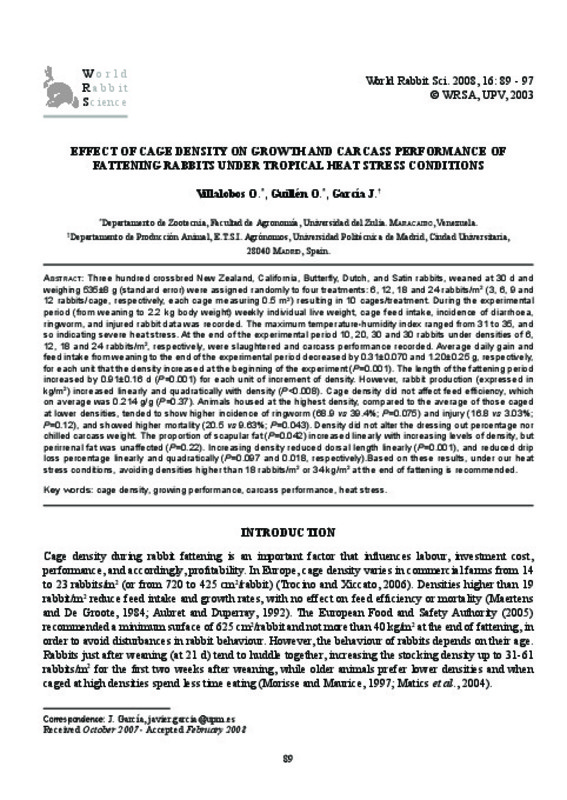JavaScript is disabled for your browser. Some features of this site may not work without it.
Buscar en RiuNet
Listar
Mi cuenta
Estadísticas
Ayuda RiuNet
Admin. UPV
Effect of cage density on growth and carcass performance of fattening rabbits under tropical heat stress conditions
Mostrar el registro sencillo del ítem
Ficheros en el ítem
| dc.contributor.author | Villalobos, O.
|
|
| dc.contributor.author | Guillén, O.
|
|
| dc.contributor.author | García J., J.
|
|
| dc.date.accessioned | 2010-08-02T11:12:26Z | |
| dc.date.available | 2010-08-02T11:12:26Z | |
| dc.date.issued | 2010-08-02 | |
| dc.identifier.issn | 1257-5011 | |
| dc.identifier.uri | http://hdl.handle.net/10251/8519 | |
| dc.description.abstract | [EN] Three hundred crossbred New Zealand, California, Butterfl y, Dutch, and Satin rabbits, weaned at 30 d and weighing 535±8 g (standard error) were assigned randomly to four treatments: 6, 12, 18 and 24 rabbits/m2 (3, 6, 9 and 12 rabbits/cage, respectively, each cage measuring 0.5 m2) resulting in 10 cages/treatment. During the experimental period (from weaning to 2.2 kg body weight) weekly individual live weight, cage feed intake, incidence of diarrhoea, ringworm, and injured rabbit data was recorded. The maximum temperature-humidity index ranged from 31 to 35, and so indicating severe heat stress. At the end of the experimental period 10, 20, 30 and 30 rabbits under densities of 6, 12, 18 and 24 rabbits/m2, respectively, were slaughtered and carcass performance recorded. Average daily gain and feed intake from weaning to the end of the experimental period decreased by 0.31±0.070 and 1.20±0.25 g, respectively, for each unit that the density increased at the beginning of the experiment (P=0.001). The length of the fattening period increased by 0.91±0.16 d (P=0.001) for each unit of increment of density. However, rabbit production (expressed in kg/m2) increased linearly and quadratically with density (P<0.008). Cage density did not affect feed effi ciency, which on average was 0.214 g/g (P=0.37). Animals housed at the highest density, compared to the average of those caged at lower densities, tended to show higher incidence of ringworm (68.9 vs 39.4%; P=0.075) and injury (16.8 vs 3.03%; P=0.12), and showed higher mortality (20.5 vs 9.63%; P=0.043). Density did not alter the dressing out percentage nor chilled carcass weight. The proportion of scapular fat (P=0.042) increased linearly with increasing levels of density, but perirrenal fat was unaffected (P=0.22). Increasing density reduced dorsal length linearly (P=0.001), and reduced drip loss percentage linearly and quadratically (P=0.097 and 0.018, respectively).Based on these results, under our heat stress conditions, avoiding densities higher than 18 rabbits/m2 or 34 kg/m2 at the end of fattening is recommended. | es_ES |
| dc.language | Inglés | es_ES |
| dc.publisher | World Rabbit Science. ICTA. UPV | en_EN |
| dc.relation.ispartof | World Rabbit Science | |
| dc.rights | Reserva de todos los derechos | es_ES |
| dc.subject | Cage density | es_ES |
| dc.subject | Growing performance | es_ES |
| dc.subject | Carcass performance | es_ES |
| dc.subject | Heat stress | es_ES |
| dc.title | Effect of cage density on growth and carcass performance of fattening rabbits under tropical heat stress conditions | es_ES |
| dc.type | Artículo | es_ES |
| dc.identifier.doi | 10.4995/wrs.2008.631 | es_ES |
| dc.rights.accessRights | Abierto | es_ES |
| dc.description.bibliographicCitation | Villalobos, O.; Guillén, O.; García J., J. (2010). Effect of cage density on growth and carcass performance of fattening rabbits under tropical heat stress conditions. World Rabbit Science. 16(2). https://doi.org/10.4995/wrs.2008.631 | es_ES |
| dc.relation.publisherversion | https://doi.org/10.4995/wrs.2008.631 | es_ES |
| dc.description.volume | 16 | |
| dc.description.issue | 2 | |
| dc.identifier.eissn | 1989-8886 | es_ES |








